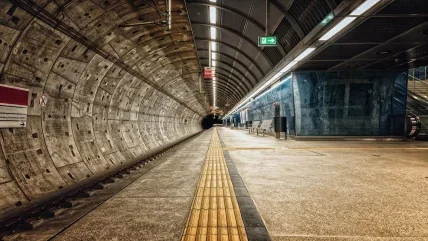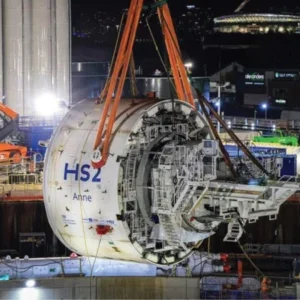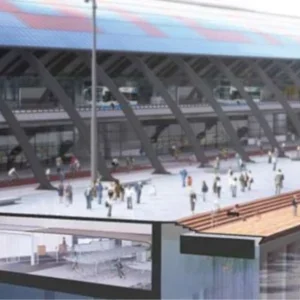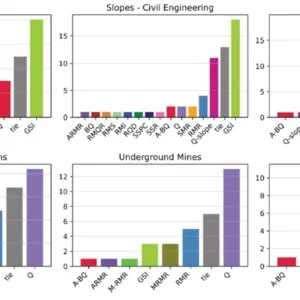
At 74.5km-long, the new Hizray underground metro project running from west to east through Istanbul is not only a major investment for the city and Turkey but also of global significance in its scale.
Hizray project is to include a total of 13 stations at 6km average intervals, two transition structures, and a major subsea crossing below the Bosphorous Strait. To be built at such scale between the European and Asian sides of the city, and running fully underground, through complex sedimentary geology of varied sandstones, claystones and limestones, the planning at this stage envisages 27 tunnel boring machines (TBMs) will be employed to build Hizray’s long tunnels.
Most of the TBMs are expected to be earth pressure balance (EPB) machines – 26 in total – for the majority of the Hizray route, running in twin 5.7m i.d. tunnels, to link stations from Beylikdüzü in the west to Sabiha Gökçen international airport, at Pendik, in the east. Approximately midway, where the route passes under the Bosphorous Strait, construction will change to a single 9.8m i.d. tunnel to be bored by a slurry TBM.
Technical briefings on the project are the focus of a special session of UYAK 2023 (the 5th International Underground Excavations Symposium and Exhibition), to be held early June, (see box panel Istanbul Conference).
Hizray is being developed by Istanbul Metropolitan Municipality’s (IBB) Rail System Directorate. While the average distance between stations on most metros is around 1km it chose intervals six times longer. The most prominent issue during the design phase of Hizray was optimising the locations of the stations.
UNDERGROUND STRUCTURES AND TUNNELLING
The project is to employ EPB machines mostly – 26 x EPBs – to bore approximately 130km, in total, of 5.7m i.d. single-track, parallel running tunnels. They approach the single larger tunnel under the Bosphorous via transition structures. After the transitions, each side of the strait will have a large TBM access shaft of more than 70m depth.
Other tunnelling works are planned for these twin tube sections of the project include New Austrian Tunnelling Method (NATM) excavations, as follows:
- Tail tunnel – (5.7m wide x 1km long)
- Turnout – (17.61m x 3.33km)
- Cross passage – main line – (5.7m x 8.16km)
- Cross passage – stations – (6.6m x 3.4km)
- Platform tunnels – (12m x 8.08km)
- Platforms connection tunnels – (9.24m x 3.32km)
- Inclined tunnels (stations) – (9.24m x 3.22km)
- Transition (at Bosphorous crossing) – (17.61m x 0.18km)
- Depot connection tunnel – (5.7m x 6.47km)
- Depot tunnel – (17.61m x 0.97km)
Bosphorous Crossing
While running in twin tube tunnels for the majority of its alignment below Istanbul,, Hizray will pass under the strait in a single, larger diameter tunnel. Transition structures will link the twin tunnels to the single larger tunnel.
Prior tunnelling experience below the strait and knowledge of ground conditions in the area helped the planning and design studies to select the most suitable geological parameters for the transition structures.
Between the transition structures, the single tunnel covers a total distance of 3390m in the middle of Hizray.
Within this central section, the single twin-track tunnel passes under the strait for a distance of approximately 1580m, and its deepest point will be about 130m below sea level.
To cross under the strait, the most suitable tunnel section was determined after consultation with TBM manufacturers and tunnel specialist engineers. A single tube as the preferred solution to various construction challenges, such difficulties with geology for cross passage construction under the strait, and also with regard to risk and consequence of possible malfunctions and maintenance needs in the subsea section.
The studies selected a 9.8m i.d. tunnel section, in accordance with NFPA standards and fire escape scenarios.
ISTANBUL CONFERENCE
Event: UYAK 2023 (5th International Underground Excavations Symposium and Exhibition)
Date: 5-7 June 2023
Location: Istanbul ITA AITES International Tunnelling and Underground Space Association, is coming to Istanbul to participate in the UYAK2023 Symposium & Exhibition with its Executive Council Members.
While it was the subject of a dedicated, introductory workshop in November 2022, the Hizray project will be a key project for discussion among the many plans for investments involving tunnel project in Istanbul, and Turkey, during the UYAK 2023 (5th International Underground Excavations Symposium and Exhibition), in early March.
The event is organised by UCTEA (Chamber of Mining Engineering) and the city authority (IBB) and has a focus on – Cities of the Future, Urban Tunnelling, and Underground Excavations.
Hizray Project is to be built in the near future by IBB’s Rail System Directorate as a fast, express metro line between the two end points of the Anatolian and European sides of Istanbul. With long, meticulous design period and optimisation studies, Hizray will be the main artery of the expanded Istanbul rail system.
Prof Dr Pelin Aplkökin, Vice General Secretary of IBB and also head of the Rail System Directorate, led a first major workshop briefing on the project in November 2022. Briefing, next, at UYAK 2023 is the next step in preparing the wider international tunnelling industry about the project with which IBB plans for Istanbul to become a more comfortable and liveable city with easier travel in less time.






